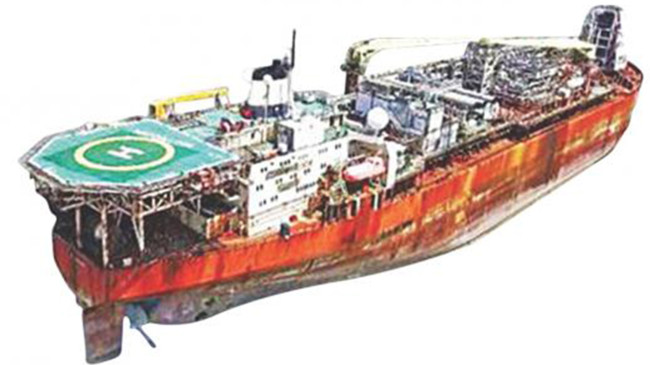Alang, the world's largest graveyard for
ships, has been notorious for its human and environmental safety standards. But
it could now be looking at a healthier future
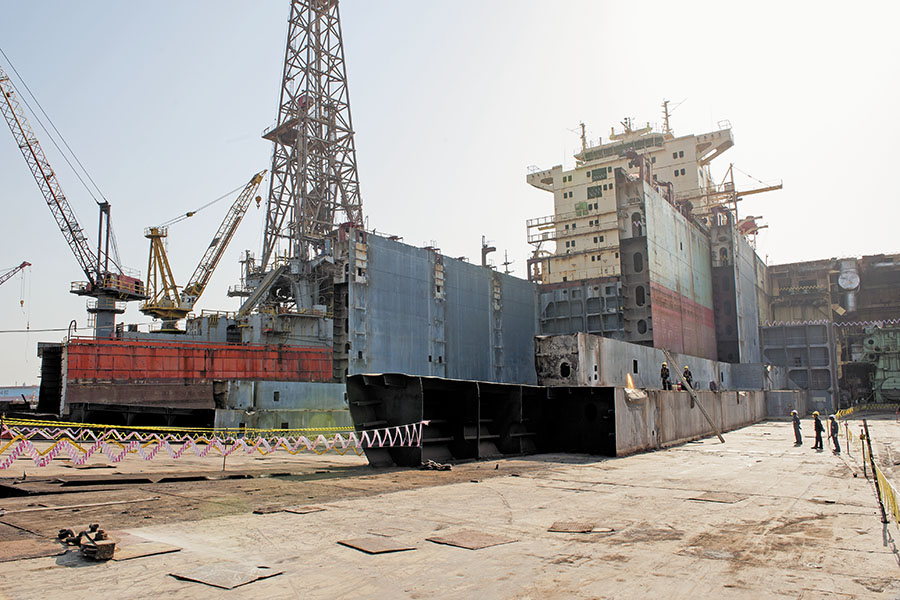 |
| Chetan Patel of the Shree Ram Group, which owns two ship recycling yards at Alang |
There is always something morbid about a
place where things are taken apart, piece by piece, after the end of their
useful lives, and sold off as scrap. A once grand, or at least useful, creation
is systematically stripped and wrenched apart, and reduced to a pile of junk;
its utility down to the cost of scrap metal.
Alang, the world’s largest graveyard for
ships, would score high on such morbidity. No wonder then that it found a place
in Max Brooks’s 2006 novel World War Z: An Oral History of the Zombie War. But
what Brooks did not include in his depiction of humans turning into zombies,
because of a global pandemic, were the real life horror stories of Alang’s ship
breaking yards that have been notorious for endangering human lives as well as
the environment for decades.
But as global calls for sustainable business
practices across industries gather volume, a few ship owners and recyclers are
determined to mend Alang’s notorious image and position it as a global hub for
responsible ship recycling.
Alang, situated 50 km from the city of
Bhavnagar in Gujarat, is a 10 km sandy stretch, facing the Gulf of Khambhat; it
is dotted with battered ships of all shapes and sizes, anchored perpendicular
to the shore. Oil and gas tankers, container vessels and even cruise liners
wait to be reduced to scrap. The yard became operational in 1983, when the
state government conceived it to create mass employment for low-skilled
workers. Alang’s yards have a capacity to break 450 ships annually, and the
industry is now worth around ₹6,000 crore.
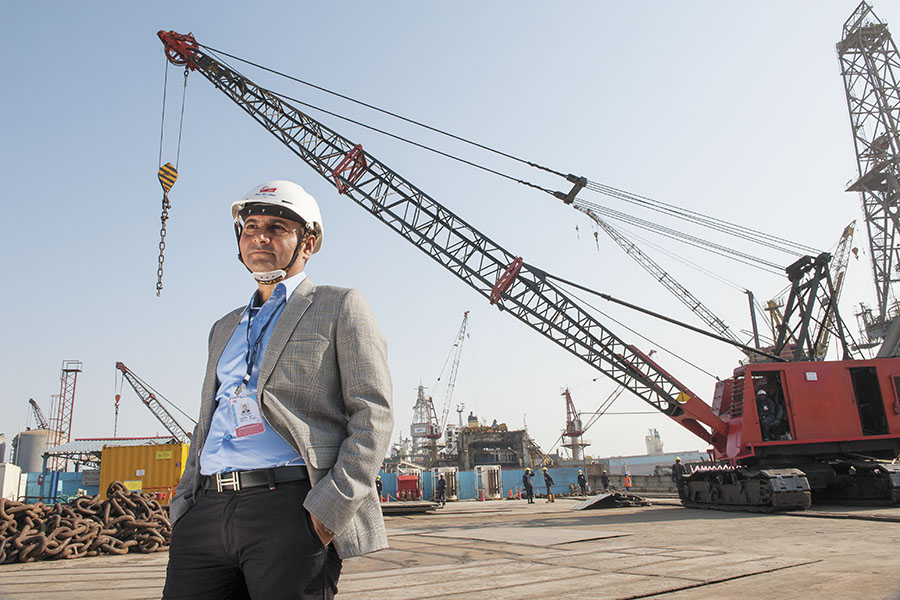 |
A partially dismantled ship at Alang. The
Gujarat town accounts for half of all ships recycled globally
|
The barren landscape on either side of the
well-laid road that leads from the highway to the Alang-Sosiya Ship Recycling
Yard is lined with shops selling every imaginable item that has been ripped
from the ships—engines, pumps, crockery, dishwashers, lifebuoys and wooden
furniture, for instance.
Deeper within Alang, the road that runs
adjacent to the 170-odd shipbreaking plots (of which around 130 are
operational) developed by the Gujarat Maritime Board (GMB), gets bumpier and
dustier. The GMB gives out yards on long-term leases to private companies to
operate them.
Most of the 17,000 men working at the yards
leave their shanties early in the morning, and head to work wearing yellow or
white hard hats, dark blue jumpsuits, and industrial boots. But despite the
safety standards that their attire suggests, most of the yards function like
haphazard junkyards: Harmful substances, such as asbestos and oil, often spill
into the water, contaminating the marine ecology; workers who use gas cutters
are exposed to hazardous fumes; there have also been reports of workers dying
due to gas explosions. A 2014 study commissioned by the National Human Rights
Commission and conducted by the Tata Institute of Social Sciences confirmed the
poor working conditions at Alang and pointed to lax implementation of safety
regulations. It found that, according to official records, 470 deaths were
reported between 1983 and 2013, with a possibility of the number being higher.
This is the price Alang pays to keep its
shipbreaking industry competitive. Similar substandard working conditions are
also rampant in the shipbreaking industries of Gadani in Pakistan and
Chittagong in Bangladesh. It is not surprising then that these three locations
account for close to 90 percent of all ships recycled in the world; Alang alone
accounts for about half.
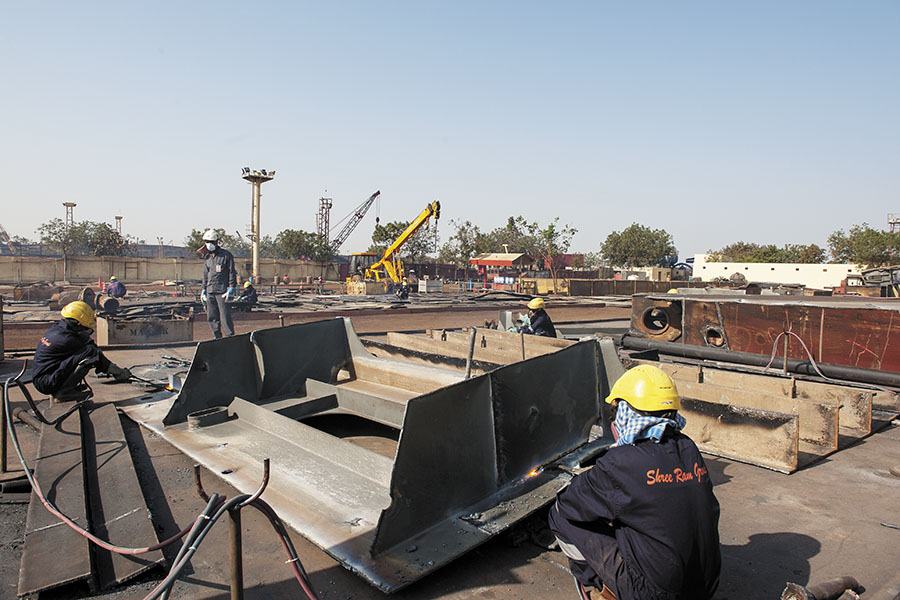 |
Both yards of the Shree Ram Group have been
certified by the Hong Kong Convention
|
The other large global ship breaking centres
are in China (Zhejiang and Jiangsu, among others) and Aliaga in Turkey, where
safety standards for workers and the environment are higher than at Alang.
The continuing slowdown in global trade, and
the consequent excess capacity in the shipping industry, means shipping
companies are scrapping more of their vessels than before. Shipping yards in
China and Turkey pay less to shipping companies for their retired ships owing
to their higher operating standards, compared to yards in Pakistan, India and
Bangladesh. But as global regulations governing ship recycling become more
stringent, shipping companies are under pressure to send their old vessels to
yards that follow safety and environmental norms, where they fetch a lesser
price.
In order to get a better price for retired
ships from yards that operate with high safety standards, a few shipping
companies are now trying to develop Alang as a yard adhering to global
benchmarks. One of the shipping lines implementing this strategy is
Denmark-based publicly listed company AP Moller-Maersk, which has $35 billion
(around ₹2.24 lakh crore) in revenue. In 2015, it tied up with Chetan Patel,
owner and director of the Shree Ram Group, and the Masani family, which owns YS
Investments, to create a benchmark for others to hopefully replicate. In 2015,
China Navigation Company (CNCo) also committed itself to the development of
Alang.
“We are working with the more far-sighted
ship recycling facilities in Alang, who committed significant quantities of
their own money to raise standards with zero guaranteed return, to move the
safety, environmental, social and operational standards from the previous,
often very poor, practices to those of a responsible industry,” writes Simon
Bennett, the Singapore-based general manager of sustainable development at
CNCo, in an email.
Annette Stube, head of sustainability at AP
Moller-Maersk’s transport and logistics division, says her company has been
sending its end-of-life ships to only responsible ship recyclers in Turkey and
China since 2009. But occasionally, if there is more life left in the ships,
the vessels are resold. “Sometimes, people reused the ships that we sold and
sent them for recycling to Pakistan or Bangladesh eventually,” says Stube.
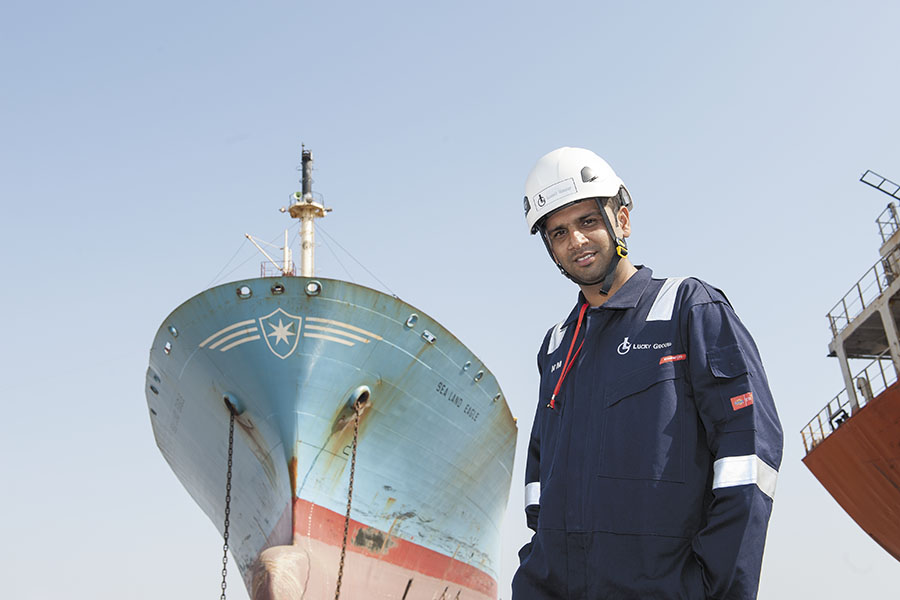 |
Naeem Masani, MD of YS Investments, whose
facility at Alang rakes in ₹100 crore annually
|
To clamp down on this practice, and to
increase the number of responsible ship recyclers to choose from, in 2015,
Maersk decided to work with some progressive recycling yards at Alang and bring
them up to global standards. “Any business would like to have many options. It
is a strategic business consideration where our position is stronger or weaker
depending on the bargaining power of the procurers,” says John Kornerup Bang, head
of sustainability strategy and shared value initiatives at AP Moller-Maersk.
CNCo’s Bennett also mentions that the
recycling capacity in Turkey and other European Union countries is “woefully
inadequate” to handle the number of ships getting scrapped. “Additionally, it
would be prohibitively expensive for CNCo to send ships trading in the Asia
Pacific region to Turkey for recycling. The market price for ships to be
recycled in China is currently skewed because of government subsidies that keep
shipyards competitive,” he adds.
While CNCo’s and AP Moller-Maersk’s rationale
for upgrading Alang is clear, what is in it for Alang’s shipbreaking companies?
Patel (42), whose business group’s interests
range from ship recycling to real estate, owns two yards at Alang that have
been certified by the International Maritime Organization’s (IMO) 2009 Hong
Kong International Convention for the Safe and Environmentally Sound Recycling
of Ships. The certification was awarded by ClassNK, a Japanese ship classification
society in 2015. Patel’s and Masani’s yards are among at least 17 yards in
Alang that have been certified by the Hong Kong Convention, which sets out
standards that cover the handling of hazardous materials, recycling facilities,
the design and construction of ships, and the preparation of ships sent for
scrap. However, it won’t come into force until it is ratified by 15 countries,
representing no less than 40 percent of the world fleet’s tonnage.
So far the Convention has been ratified by
only six countries around the world—Norway, Congo, France, Belgium, Panama and
Denmark. It is expected that by 2018-19, many more countries will ratify the
Convention, which would make it difficult for the non-certified yards at places
like Alang to get new business.
The breaking and recycling of ships in India
is supposed to follow the Shipbreaking Code 2013, issued by the Union ministry
of shipping.However, the ministry itself had come under flak from environmental
groups for not factoring in pollution. Consequently, the ministry issued
amendments in 2016 that covered issues such as treatment of radioactive and
hazardous waste material.
Patel’s father Mukesh started the Shree Ram
Group in 1994. It has recycled close to 280 ships since then, and brings in
₹300 crore in revenues each year. He has spent ₹2.5 crore for one yard, and a
little more for the other (which is bigger in size), to instal impermeable
flooring in the front yard (where metal blocks from the ship first land) and
backyard (where the blocks are cut into smaller pieces) to prevent soil and
water contamination; a mechanism to use the hull of the ship as a safety net to
prevent metal blocks falling into the sea; a high-tonnage crane to lift the
blocks and bring them to shore; pipelines for transferring used ship oil; and
high-quality safety gear and emergency response systems.
YS Investments has spent close to ₹13 crore
on similar upgrades at one of their facilities, which has an annual turnover of
₹100 crore. “We are thinking about how our business will evolve over the next
10 years,” says Naeem Masani, 28, managing director of YS Investments. For the
Masanis, their Alang yard is also a source of scrap steel for their steel
rolling mills in Bhavnagar, and the used ship oil is utilised in the lubricants
they manufacture.
In addition to the Hong Kong Convention, AP
Moller-Maersk has made Shree Ram Group and YS Investments adhere to its own
Responsible Ship Recycling Standards (RSRS), which prescribe additional safety
measures under which its own experts stationed at the yards have the authority
to stop work if they observe any lapses. AP Moller-Maersk has decided to sell
two ships to Shree Ram Group and one to YS Invesments at a discount, and has
committed a steady supply of ships to these facilities as long as they maintain
their standards.
While the Hong Kong Convention doesn’t
specifically address the working conditions for yard workers, AP Moller-Maersk
and CNCo are trying to ensure that Masani and Patel construct International
Labour Organization-compliant dormitories for workers as part of the overall
facelift of their facilities.
The next goal for Patel is to get his yards
certified according to EU’s standards, so that he can then buy retired ships
from European shipping lines (the EU Ship Recycling Regulation of 2013 require
EU-flag ships to be recycled only at facilities they recognise).
But even as Patel aims to further improve his
yard, a canister of chemical falls into the ocean from a ship at a yard next to
his. The chemical fumes rising from the water serve as a grim reminder that
while a beginning has been made to redeem Alang, more needs to be done to break
old mindsets and not just ships.
Source:
forbes india. 20 September 2017






